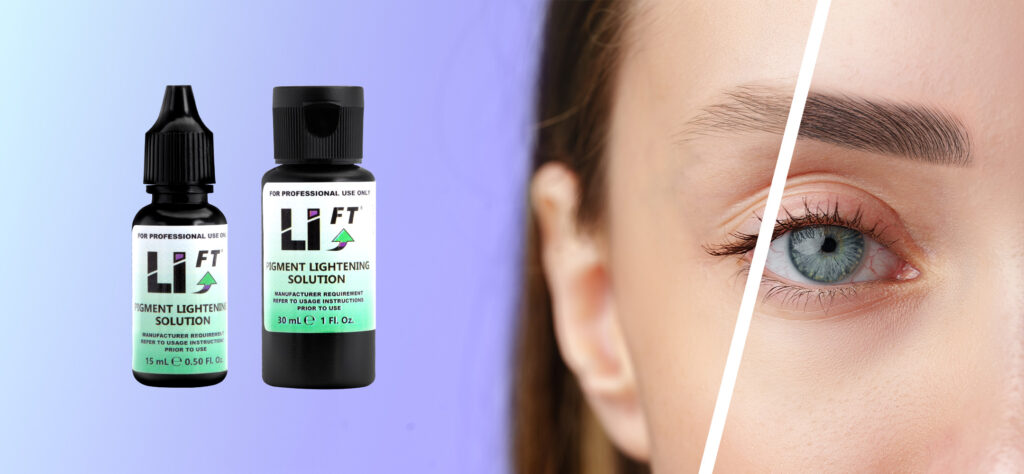What is salt-saline tattoo removal?
Saline solution tattoo removal is a natural and safe method for removing permanent makeup.
In short, it works by lightening and lifting the pigments that were placed under the skin during a PMU treatment. The level of discomfort is no more than the initial procedure, and this type of removal is suitable for removal of pigments from the face where scarring and hyperpigmentation are more noticeable.

How does salt saline removal work?
Saline removal uses osmosis as a way to pull the pigment out of the skin. To do so, a trained permanent makeup artist will use their standard PMU machine and needles with a product like the Li-FT Lightening Solution, which will be made of salt, purified water and other skin-safe ingredients.
Once the solution is under the skin, it effectively pulls at the pigment, helping to draw it up through the layers of skin to the fresh wounds.
Over the next few days, the area will form a scab, just like it did when the pigments were first implanted. The pigment is drawn up into the scab, so that once it’s healed and dropped off, it takes the pigment with it! Clients will likely need a few sessions to see the full effectiveness of the removal but this will be judged by the technician on a case by case basis, with sufficient time between sessions to allow for healing.
What are the benefits of tattoo saline removal?
There are a few reasons why artists love offering salt and saline tattoo removal, and why clients would rather pick this than a laser!
Lightening solutions like the Li-FT remover are made from all-natural ingredients, which is perfect for clients looking to avoid harsh chemicals or laser damage - especially around delicate areas, like for eyeliner PMU.
The cost to carry out this procedure is pretty low, keeping prices down for both the artist and the client, and it’s easy to learn with Becci Gibbons’ dedicated training course.
Some other forms of pigment removal don’t work as well on certain shades and colours, or might lead to discolouration, which is obviously not desirable on the face! Plus, it has no known effect on hair growth in the area,and is suitable for all skin types.
Do you need training to use this technique?
100% YES.
No PMU artist should be carrying out this procedure without first completing an accredited training course, like the one run by Becci Gibbons. It’s up to you to make sure that the course you pick is suitably accredited.
The courses are usually tied to a particular product, and you may have to show proof of your qualification before you can buy these solutions.

What is the best pigment lightening solution to use?
Our favourite form of lightening is Li_FT Pigment Lightening Solution. It’s safe, effective, developed by the chemists at Li Pigments and made from all-natural ingredients and sterile water.
There are no harsh acids or chemicals in here - just natural ingredients like Aloe Barbadensis, Calendula extract, orange and lemon seed extracts and of course ultra finely ground salt.
Aloe is chosen for its soothing, healing properties, while Calendula is anti-fungal, anti-bacterial and anti-inflammatory. Lemon and orange seeds are great for fading and exfoliation, and all these ingredients help to speed up and improve the process.
Other ways to remove PMU
Salt saline is the most natural way to remove PMU pigments, but there are alternatives!
Laser removal is one of the most common forms of tattoo removal. It works by shooting high-intensity lasers at the skin which breaks down the underlying particles, allowing the body to do what it does best and clean them up.
But laser removal on a limb is one thing; on the delicate skin of the face it can easily cause a lot of damage, and particular care needs to be taken around the eyes. What’s more, these lasers target specific colours of pigment, often working best where there’s a high contrast between the skin and pigment tone, so it may not work for lighter pigments or on darker skin tones.
Another form of removal uses glycolic acid. It’s applied in a similar way to salt saline removal, except that the acid breaks down the bonds between skin cells, allowing the pigment to rise more easily to the surface.
Glycolic acid may be more effective than the saline method, but it can also penetrate too deeply and cause irritation or even permanent scarring.
Alternatives to permanent makeup removal
As we discussed in our blog about PMU removal, there are ways to mitigate the need for these treatments.
Covering up or correcting the treatment with another one can be very effective, but absolutely won’t work if the initial treatment was too saturated or dark! If you make sure to work lighter to create a softer look, your work may be easier to correct later on, with clever use of colour theory.
You could also use a pigment made from inorganic materials, which heals softer and fades faster than organic materials. This is the perfect solution for clients trying out a new colour or shape!
You can pick up the Monia Ivani Signature Series, which is made with inorganic pigments, or opt for the Tina Davies FADE set, which is specifically designed to fade over 12-24 months.

Training in methods of PMU removal is a great way to increase the treatments you can offer clients, and seeing the results may even help you to improve your own permanent makeup.
Just don’t skimp on your accredited training course - our recommendation would be to head to the official website to find a trainer local to you and enroll in a course on how to use Li-FT Pigment Lightening Solution!
